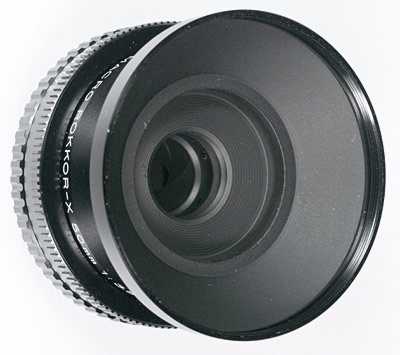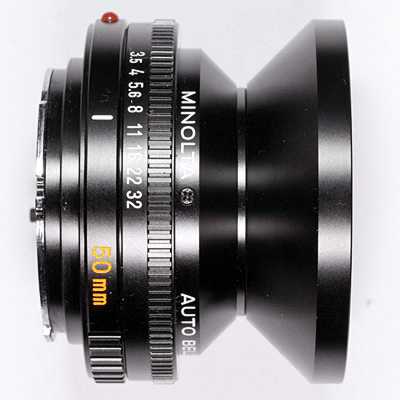MINOLTA 50mm BELLOWS LENSES
Minolta sold and made a wide range of lenses designed for use on a bellows and for micro-photography. At
one end of the spectrum were the 12.5mm lenses. These are really microscope lenses and function admirably
in that capacity having a standard microscope thread. But Minolta knew that many users would be photographers
and many would want to use this lens in the field. Their first attempt was to take a Leitz microscope lens
and add an adapter which has a microscope thread on one side and a Minolta SLR bayonet on the other. Part
of the manufacture of the lens was probably handled by Minolta, but the product had the Leitz name on it. It
was very expensive and sales were sluggish.
This lens can be used on most microscopes with a 23.5mm thread or it can be used on any Minolta-mount bellows
with a suitable adapter. There were three adapters to convert microscope-threaded lenses onto the Minolta mount.
The M adapter was produced in the Leitz/Minolta era for the Photar lenses. It has about 20mm of extension.
Later, Minolta made the flat M-1 Adapter, and the M-2 Adapter which has about 40mm of extension.
Bellows lenses are sometimes referred to as short-mount lenses since the part of the lens barrel that focuses
the lens is gone. It's not needed since these lenses are designed to be used on a bellows and the bellows
does the focusing. This keeps the lenses small, light and less expensive. You can actually use enlarging
lenses as a bellows lens. All you need is an adapter. The results are superb, so you can save some
money if you already own a enlarging lens. Just make sure it is a top quality enlarging lens like the Minolta
Rokkor enlarging lenses. Bellows lenses have certain advantages over enalrging lenses in use, but optically
they are very similar. However, 12.5mm enlarging lenses were never made. The closest you'll come is
a 15mm Minox lens which would require a special home-made mount.
Minolta made bellows lenses in five focal lengths:
They also made a wide variety of enlarging lenses that make exellent bellows
lenses with the correct adapter. In addition, they made macro lenses in 50mm
and 100mm lenses which allow close-up phogograhy WITHOUT a bellows, but if you REALLY
want to get close, you need a bellows and a bellows lens!
MINOLTA 50mm BELLOWS LENSES
|
LENS FEATURES
|
IMAGE
|
COMMENTS
|
|
FOCAL LENGTH: 50mm
f-STOPS: 3.5-32
PERIOD: 1977-1981
INSCRIPTION:
EARLY STYLE: MINOLTA LENS MADE IN JAPAN MD ROKKOR-X 1:3.5
f=50mm
LATE STYLE: MINOLTA MD ROKKOR-X 50mm 1:3.5 LENS MADE IN
JAPAN ø55mm
DESIGN: 6/4
FILTER: 55
DIAPHRAGM: auto
MC: no
MD: no
CLOSE FOCUS: --
SIZE: 2.2"x1"
WEIGHT: 4.1oz.
|

|
This lens was first introduced in the
MD Rokkor-X series at the same time as the Minolta Auto Bellows III. It is a short-mount bellows lens, like the
earlier 135mm and 100mm bellows lenses, but offers closer focusing capability due to its shorter focal length.
This light, compact lens has a 34mm filter thread and an accessory lens shade that has a 55mm filter thread on
the front. With the lens shade attached, filters can be used on the front, or if space is limited, in a special
34mm gelatin filter holder that is placed between the lens and the lens shade. This lens filled an important gap
in the Minolta line-up of bellows lenses. Before this, Minolta had 12.5mm, 25mm, 100mm and 135mm bellows lenses,
but no moderate focal length bellows lens. The only option was to use a normal 50mm or 55mm lens reversed -- an
awkward approach.
|
|
FOCAL LENGTH: 50mm
f-STOPS: 3.5-32
PERIOD: 1981-present
INSCRIPTION: MINOLTA AUTO BELLOWS MACRO 50mm 1:3.5 JAPAN
DESIGN: 6/4
FILTER: 55
DIAPHRAGM: auto
MC: no
MD: no
CLOSE FOCUS: --
SIZE: 2.2"x1"
WEIGHT: 4.1oz.
|

|
Identical to the MD Rokkor-X 50mm 3.5
bellows lens but sold at the same time as the MD Minolta series.
|
COPYRIGHT @ 1995-2021 by Joe McGloin.
All Rights Reserved. The material on this website is protected by US Federal copyright laws. It cannot be copied
or used in any manner without specific approval from the owner.
The material on this website is protected by US Federal copyright laws. It cannot be copied or used in any manner
without specific approval from the owner.

